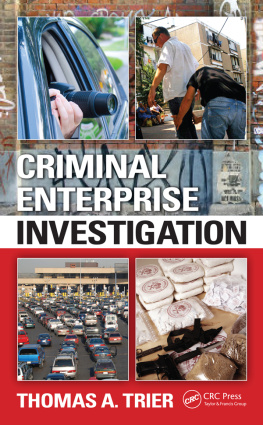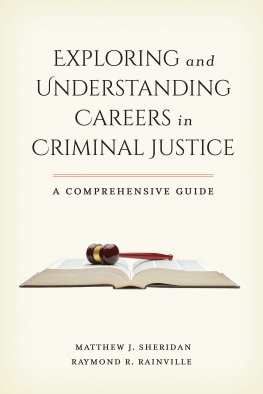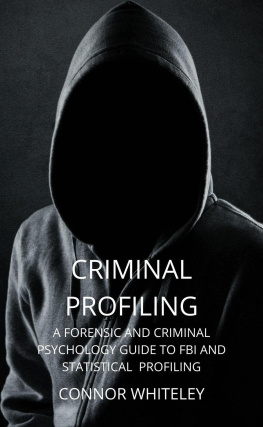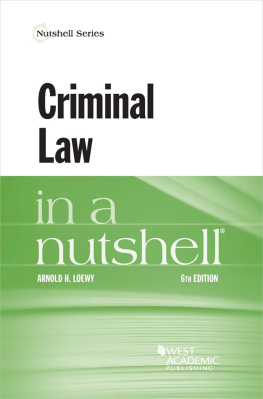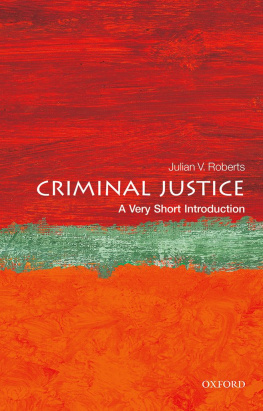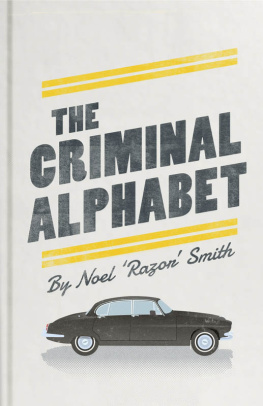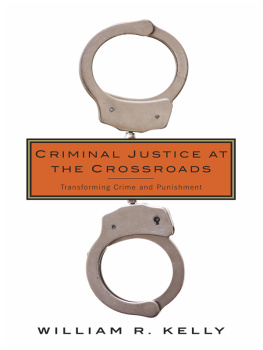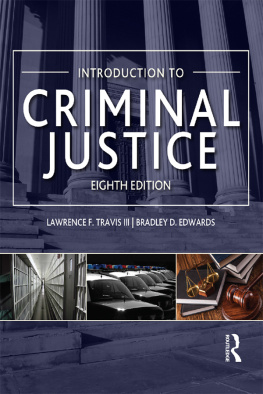CRIMINAL
ENTERPRISE
INVESTIGATION
CRIMINAL
ENTERPRISE
INVESTIGATION
THOMAS A. TRIER

CRC Press
Taylor & Francis Group
6000 Broken Sound Parkway NW, Suite 300
Boca Raton, FL 33487-2742
2017 by Taylor & Francis Group, LLC
CRC Press is an imprint of Taylor & Francis Group, an Informa business
No claim to original U.S. Government works
Printed on acid-free paper
Version Date: 20160706
International Standard Book Number-13: 978-1-4987-5944-1 (Hardback)
This book contains information obtained from authentic and highly regarded sources. Reasonable efforts have been made to publish reliable data and information, but the author and publisher cannot assume responsibility for the validity of all materials or the consequences of their use. The authors and publishers have attempted to trace the copyright holders of all material reproduced in this publication and apologize to copyright holders if permission to publish in this form has not been obtained. If any copyright material has not been acknowledged please write and let us know so we may rectify in any future reprint.
Except as permitted under U.S. Copyright Law, no part of this book may be reprinted, reproduced, transmitted, or utilized in any form by any electronic, mechanical, or other means, now known or hereafter invented, including photocopying, microfilming, and recording, or in any information storage or retrieval system, without written permission from the publishers.
For permission to photocopy or use material electronically from this work, please access www.copyright.com (http://www.copyright.com/) or contact the Copyright Clearance Center, Inc. (CCC), 222 Rosewood Drive, Danvers, MA 01923, 978-750-8400. CCC is a not-for-profit organization that provides licenses and registration for a variety of users. For organizations that have been granted a photocopy license by the CCC, a separate system of payment has been arranged.
Trademark Notice: Product or corporate names may be trademarks or registered trademarks, and are used only for identification and explanation without intent to infringe.
Library of Congress Cataloging-in-Publication Data
Names: Trier, Thomas A., author.
Title: Criminal enterprise investigation / Thomas A. Trier.
Description: 1 Edition. | Boca Raton : CRC Press, 2017. | Includes bibliographical references and index.
Identifiers: LCCN 2016007072 | ISBN 9781498759441
Subjects: LCSH: Criminal investigation--United States.
Classification: LCC HV8073 .T7295 2016 | DDC 363.250973--dc23
LC record available at https://lccn.loc.gov/2016007072
Visit the Taylor & Francis Web site at
http://www.taylorandfrancis.com
and the CRC Press Web site at
http://www.crcpress.com
CONTENTS
The reason I wrote this book was to assist law enforcement officers, prosecutors, academics, security professionals, and investigators to understand and develop the principles to dismantle criminal enterprise organizations.
Why is this subject relevant? Why even write a book on how to dismantle criminal enterprises? Who are they? What do they do?
Based on my 28 years of law enforcement experience, I have seen gangs, drug cartels, terrorist cells, and family-based criminal organizations operate with impunity across the spectrum of American communities.
They exist in large metropolitan and rural communities alike. Criminal enterprises are present in many communities, and they usually control the majority of criminal activities in their areas of operation.
You have seen criminal enterprises documented in popular books and movies such as The Godfather, Goodfellas, and countless other media accounts.
You see real gang shootings and murders on the evening news. Members of criminal enterprises are hidden in communities across the United States.
Whether the criminal enterprise is the Mafia, an Asian Triad, a local gang, or a family of career criminals, they thrive in shadow and anonymity.
Local law enforcement may be aware of the existence of a group of guys committing crimes in their jurisdiction. They arrest them all the time. But they might not realize they are part of an organized crime group. Local cops will arrest members of the criminal enterprise when they break the law. The cops will charge the individuals with the crimes they are committing, say robbery. They may never tie the robberies to a criminal enterprise. That is not to say that local police are not smart or street wise.
Many local cops are sharp. They will figure out their career offenders are part of a criminal enterprise. But they generally lack the resources and expertise to tackle the entire criminal enterprise. They just may not know how to attack the criminal enterprise and dismantle it. Often, they arrest the same people over and over. The police just write it off to career criminals in their jurisdiction, and there isnt much they can do about it.
I believe there is a need for application of the Criminal Enterprise Investigation (CEI) in these situations. The CEI methods call for intelligence-based criminal investigations of entire criminal enterprises.
The CEI path requires tracking the criminal activity in an area and identifying patterns of criminal activity by the same criminal subjects. Through this tracking and analysis, crime problems can be identified and addressed before they become major events.
For example, any law enforcement officer can effect an arrest and obtain a conviction on an individual based upon overwhelming evidence. However, it takes an additional expertise to identify an emerging crime problem to
1.Identify a criminal enterprise operating behind the crime.
2.Initiate a working group to address the criminal enterprise.
3.Disrupt its daily operations.
4.Manage the criminal activity and emerging patterns.
The end game is the dismantlement of the entire criminal enterprise by rooting it out, disabling it from operating, and getting rid of it altogether.
This book will cover the high points of assembling a working group or task force to attack a criminal enterprise.
The CEI process is a little more complicated than working a standalone violent crime investigation. In the lone violent crime, the process usually follows the following pattern. The investigator must identify the crime committed. Then they must identify the person who committed the crime and find the motive, opportunity, and method of committing the crime. Then the investigator must gather evidence and compare the evidence to the elements of the crime. The investigator must present the evidence to a prosecutor for charging. The investigator must then assist the prosecutor in proving the crime in a court of law beyond a reasonable doubt.
The CEI process requires each individual crime investigated in the overall case be held to the same standards. However, there are several additional areas required to investigate and dismantle a criminal enterprise. The CEI process usually includes the following additional components:
Identifying a crime problem
Identifying the organization
Identifying personnel
Identifying leaders, members, and associates
Identifying an organizational structure
Proving a criminal enterprise
Locating and tracking finances
There is also a constant stream of intelligence collected during the course of a CEI. This intelligence must be analyzed, evaluated, and converted to actionable items to assist in the dismantlement of the criminal enterprise. Each of these components will be covered in detail in the chapters of this book.

